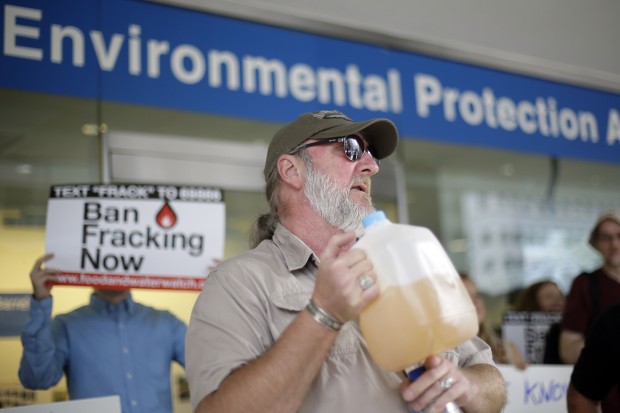DEP publishes details on 248 cases of water damage from gas development

Matt Rourke / Associated Press
Ray Kemble of Dimock, Pa. displays a jug of what he identifies as his contaminated well water in this August 2013 file photo.
For the first time, Pennsylvania environmental regulators are publicly releasing documents about cases when natural gas operations have damaged private water supplies.
A list of 248 incidents is now available on the Department of Environmental Protection’s website with links to the letters sent to homeowners when the agency determined their water well was impacted by gas development.
The DEP provided an early copy of the list to the Pittsburgh Post-Gazette in July, which showed 209 cases. The updated tally is the result of a more thorough search of paper records in regional offices, said spokesman Eric Shirk.
“As we do get more information, we will keep this list updated,” he said.
DEP says incidents on the decline
Homeowners’ names and addresses have been redacted, but the list shows wells were contaminated or produced less water in spots across the Marcellus Shale since late 2007. It includes impacts from both conventional and unconventional operations.
A majority of the incidents occurred in the Northwest and eastern regions of Pennsylvania. The state’s most-drilled county, Bradford, saw 52 incidents of degraded water supplies – more than any other county.
According to the DEP, these cases have been on the decline since a peak in 2010, and are a small number compared to the 20,000 wells that have been drilled in Pennsylvania over the last six years.
“In perspective, the percentages are good,” Shirk said.
So far in 2014, the DEP has issued 11 determination letters, most recently as August 4 in Springfield Township, Bradford County. Shirk said the agency’s goal is to make sure there are no future incidents.
“I think 200 or so contamination cases is pretty alarming numbers especially when you consider industry runs around saying they’ve not contaminated any water well supplies,” said Steve Hvozdovich with Clean Water Action Pennsylvania.
The oil and gas industry has long held that their operations – specifically the process of hydraulic fracturing – do not negatively impact water supplies.
In a statement, Marcellus Shale Coalition president Dave Spigelmyer said the documents released by DEP reflect Pennsylvania’s “long-standing water-related challenges.”
Pennsylvania is one of two states that does not have standards for private water wells. Cases of methane gas migrating into aquifers have existed long before the shale boom, but faulty well casing can speed up the process.
“Our industry works closely and tirelessly with regulators and others to ensure that we protect our environment, striving for zero incidents,” Spigelmyer said.
“They’re playing catch-up”
Environmental groups are welcoming the release of the determination letters, but remain critical of the DEP for not providing consistent details to the public.
Hvozdovich points out that information contained in each letter varies and it is not clear whether the homeowners were satisfied by DEP’s efforts to correct the problems or work with companies to replace damaged water supplies.
The release of these documents follows a report by the state’s auditor general criticizing the DEP for mishandling complaints about water quality and drilling, including poor record-keeping.
“They’re playing catch-up as fast as they can because I think frankly they’re red-faced about it,” said Tracy Carluccio, Deputy Director of the Delaware Riverkeeper Network.
Act 13, Pennsylvania’s two-year-old oil and gas law, requires the department to to post an online list of “confirmed cases of subterranean water supply contamination that result from hydraulic fracturing.”
Auditor General Eugene DePasquale said the agency has been following the letter of the law, but not “the spirit of the law.”
Shirk said the list is part of an ongoing effort to increase transparency and respond to requests from the public and the media.
“It’s not a secret the DEP has been a paper-based agency and these records have been housed in the regions where the issues were occurring,” Shirk said. “But we took the steps to manually scan in all these files and make a central repository on the Web that everybody can take a look at.”
















